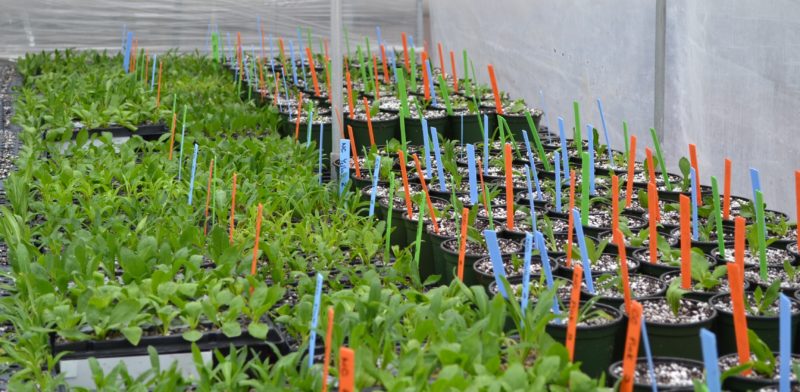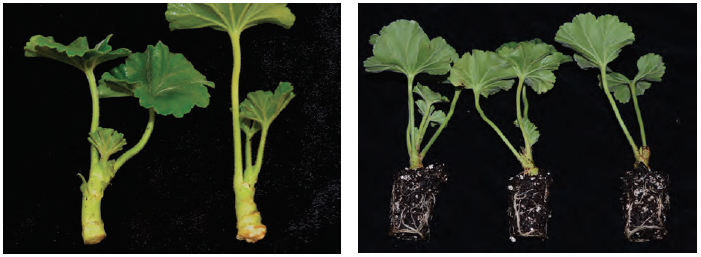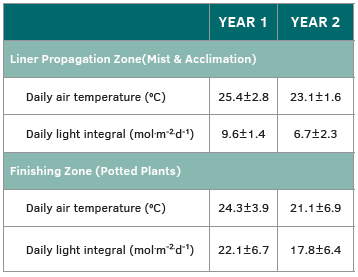
Cutting Types and Transplanting Strategies
Most vegetatively propagated herbaceous plants are grown from unrooted cuttings (URCs) to produce a rooted liner transplant. However, callused cuttings provide an alternative with potential to increase profitability by reducing crop time compared with a URC, and have a lower plant cost than a rooted liner. Callused cuttings are more resistant to dehydration during propagation than URCs, root more quickly, and have less shrinkage (crop losses). Labor, which is an increasing challenge for our industry, can potentially be saved by transplanting a callused cutting into the final container (direct sticking), bypassing the need for a rooted liner stage.
Callusing is the first step in protection of the wound after a cutting is harvested. The callus is formed of mainly undifferentiated cells at the wound site (Figure 1). Callus in most species is a necessary precursor to adventitious rooting. In commercial propagation, callus is initiated under high moisture conditions, often in combination with an auxin rooting hormone application.
However, there is limited research on the effect of callusing on production time and shrinkage for bedding plants. This information is needed to support grower decisions on when it is most profitable to use unrooted cuttings, callused cuttings, or rooted liners (Figure 1). In this article, we discuss an experiment run at the University of Florida over two years, collecting information about production time and shrinkage. We investigated two scenarios:
Liner stage: Production time and rooting losses (shrinkage) to produce a rooted liner from either unrooted cuttings (URCs) or
callused cuttings.
Finished stage: Production time and shrinkage to produce a 4-inch finished potted flowering plant from direct transplant of either unrooted cuttings (URCs) or callused cuttings, or transplant of a rooted liner.

EXPERIMENT LAYOUT AND CONDITIONS
The experiment was carried out at the University of Florida from March to June 2015 and from February to May 2016. We chose four species including bracteantha (four crops tested) and osteospermum (four crops) because URCs can be difficult to ship and root, scaevola (six crops) because it is a slow-rooting species, and pelargonium (zonal geranium, two crops) because growers have had experience with pelargonium as a callused cutting for many years.
Two types of cuttings (callused and unrooted) were received for all varieties. Cuttings were produced in Central America from two breeding companies, and each supplier provided different varieties. All species arrived in good condition and were transplanted within 24 hours. We measured time to a finishing and the percent shrinkage when:
1. Producing a rooted liner to a transplantable stage (Figure 2) from either (a) URC or (b) callused cutting. Eighty-four cuttings per type per variety were transplanted in 25 mm liners (Ellepot brand paper-wrapped pots in propagation trays) for bracteantha, scaevola and osteospermum or 30 mm liners for pelargonium. Each 84-count tray was cut into four 21-plant sections so that partial trays could be randomly located on the benches.
2. Producing a finished flowering plant (with at least three open blooms or florets, and foliage covering the soil, Figure 3) from (a) direct transplanting a URC, (b) direct planting a callused cutting, URC or rooted liner) and variety were transplanted into 4-inch diameter pots.

The layout of the experiment is shown in Figure 4, including propagation and finished zones. After misting and acclimation in the propagation zone, cuttings were moved to the finishing zone (picture on bottom) until plants were at a shippable stage. For all URCs except pelargonium, rooting hormone was applied at 0.1 percent IBA. Immediately after transplant, Capsil surfactant at 0.3 cc/liter was sprayed on foliage.
Temperature and light conditions for these zones can be seen in Table 1, with higher light levels in the finishing zone.
Callused cuttings in liners were hydrated under mist and then moved off mist in less than 12 hours. These plants remained in the liner propagation zone until transplant into 4-inch pots. Unrooted cuttings in liners were removed from mist as soon as they had root initials, and also remained in the propagation zone until transplant into 4-inch pots. Direct transplant cuttings were similarly started under mist, and moved to the finishing zone when roots were to the edge of the 4-inch pot. Rooted liners that were transplanted into 4-inch pots were grown without mist in the finished plant zone.

Decisions for moving cuttings and transplanting liners were based on observations taken three times per week. When 90 percent of liner cuttings had roots to the edge, they were moved from propagation to finishing zones. When 90 percent of liner cuttings were at a transplantable stage (Figure 2), they were transplanted to 4-inch containers.
TRIALS RESULTS
Our trial results are separated into the two production stages (producing a rooted liner, followed by producing a finished potted plant).
Liner stage from either URCs or callused cuttings
For the liner stage, callused cuttings produced a transplantable liner more quickly than from a URC. The average reduction in time using callused cuttings was one week, with an average 10 days shorter production time for bracteantha and osteospermum using callused cuttings, nine days for pelargonium, and three days for scaevola. However, there were no differences in finished time between callused cuttings or URC for two of the six scaevola crops we evaluated. We observed limited scaevola callusing on some received cuttings and conclude that without adequate callusing, there was no difference between a callused cutting and an URC. Shrinkage was highest for bracteantha URCs, and overall was lower with callused cuttings compared with URCs.
Finished plant stage from URC, callused cutting or liner
A rooted liner produced a finished 4-inch potted plant in an average 30 days less time than direct transplant of URCs (Table 3). Direct transplant of URCs also had greater shrinkage (averaging 11.9 percent) compared with rooted liners (no shrinkage). We observed up to 50 percent losses in the most sensitive osteospermum crop. Direct transplant of a URC was therefore not considered a feasible approach for the cutting varieties tested other than pelargonium.
Callused cuttings performed better than URCs, and losses only occurred in one of the six scaevola crops tested. However, the production time with callused cuttings still averaged 24 days longer compared with a transplanted rooted liner.
During the peak season when space and time are at a premium, use of rooted liners would be favored over callused cuttings because of shorter production time. However, in the off-peak or when production space was low-cost or not limiting, then callused cuttings would be favored in order to reduce plant material costs compared with rooted liners.
CONCLUSIONS
There was a clear benefit of using a callused cutting compared with a URC when producing a liner. Shrinkage was lower with callused cuttings than URCs, and production time was reduced resulting in greater space and time efficiency. For two scaevola varieties, our results showed no difference in production time between URCs and callused cuttings, and further testing would be needed to see if this was just a result of the shipments received or if this was a consistent trend for this species.
With direct transplanting, callused cuttings also produced a finished flowering plant more quickly than URCs and with less shrinkage. However, production time of a finished flowering plant from direct transplant callused cuttings averaged three weeks longer than transplanting of rooted liners.
We recommend that you test callused cuttings in your own greenhouse conditions to evaluate rooting time and efficiency. Trial more than one shipment from your cutting supplier to evaluate the consistency of rooting.
In our next article, we evaluate these results from a financial perspective: the profitability of different types of plant material, considering the price to purchase a URC, callused cutting, or rooted liner compared with their production time and shrinkage.
Acknowledgements: We thank the industry sponsors in the Floriculture Research Alliance (www.floriculturealliance.org) and USDA-ARS Floriculture and Nursery Research Initiative #58-3607-8-725 for supporting this research, Knox Nursery for providing Ellepots, and Ball FloraPlant and Dümmen Orange for cuttings.


 Video Library
Video Library 




















